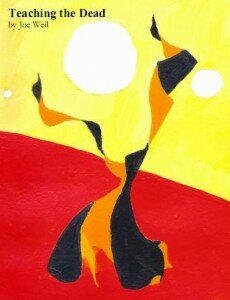On a recent gloriously sunny afternoon, I had the privilege of sitting down to talk over lunch with the poet Anne Winters, author of two critically acclaimed volumes of poetry and several translations. I was introduced to Ms. Winters’ work in graduate school and, ever since, have been an ardent admirer of her lushly orchestrated, yet intimate and searingly honest poems about the “big issues” that so many contemporary poets seem to shy away from: race, class, poverty, and gender. Or, more to the point, the intersection of these forces playing out in individual lived experiences, including those of the poet. Fittingly for a poet raised in New York City and for whom that city serves as muse, subject and mise en scéne, Ms. Winters chose to meet at Saul’s, a Jewish delicatessen incongruously nestled in the heart of Berkeley, CA, where she now resides. Over outsized latkes and steaming bowls of matzo ball soup, we discussed life in Berkeley (it really is paradisal); the joys and pains of translating Homer; the real subject of her poems; opera, French poetry; dinner parties with Elizabeth Bishop; teaching; the allure of distractions for the writer and a great many other subjects. Unassuming, gentle, and brilliant, Ms. Winters gracefully guided the ship through the waters of High Art, culture and scholarship without making me feel too much like a landlubber. An abbreviated selection from our discussion below highlights the origins of Ms. Winters’ poetic material and creative process.
One of the first questions I had for Anne was about her writing process–given the layered complexity and scope of almost every one of her published poems, I asked her how long it took to write a “Winters” poem.
Anne: I write slowly… it takes me so long and I am so obsessive.
And your poems have a density and formal perfection that bear the mark of that labor. Do you write every day? Or do you have periods where you have bursts of intense activity?
Well, sometimes life has been very good. It’s been very smooth. You just get out of bed and write. Especially when I was married and before I had Elizabeth, my daughter. So I wrote my first book, well my first book I threw out, but I wrote my second book under those circumstances. And I went on adding to it during the lifetime of my daughter, but after she came she was my first priority in a very conscious way. I find it easy to understand Elizabeth Bishop’s way of writing.
What is it about her poems that speaks to you?
There is so much latent, and yet, in spite of working so hard, she has this very conversational surface.
Yes, and there is such a strong presence of a voice, a mind filling the poems. I think this is true in your poems as well, though the voice of course is quite different from Bishop’s. In your poems, there is this quality of being at once an individual I, an observer, and yet able to encompass a much larger consciousness. How do you craft the voice in your poems?
Well, I’ll give you an example. I wrote a poem about a girl who was killed in a kind of a brothel that was opposite the house where I grew up [“The Street”]. It took me months to figure out who should speak the poem. In the final draft it was me, but I kept trying other things: my sister Vicky, my friend Charlene, a black girl on the block. I wrote drafts in all these modes. It took me a while to figure out who should be talking. I finally couldn’t settle on anything better than that bay window.
Well, in that poem, there is the I speaker, but then there are the eyeglasses and the compact. There are all these lenses and mirrors through which that scene is being viewed.
Yes, there is an awful lot going on in that poem….about gender.
Say more about that.
When I was writing that poem, I called my sister, and I said, “I don’t know if you remember it, but there was this girl…,” and she said, “Oh, I’ve remembered that all my life. I never talked about it, except about every ten years, I’d suddenly start talking a blue streak about it and then I couldn’t stop.” It had been a great trauma to her as to me to see that woman killed so regardlessly and to see the people not helping her and above all to see my father not helping her.
The poem has that beautiful line about that: “from that we learned and learned.”
[…]She’d worked to please the ones inside that house
and now the stiff pageboy lay tumbled–black threads of it
wetted red–her cheek on the place where shoes
walked, dogs stopped–this was what was, other things
what people said. And to that I must add, by our own stillness most of all
we were taught; from that we learned and learned.
It was a strong education. That poem is one that gets more objections than any other. You shouldn’t write about that. It’s okay to kill women, but it’s not okay to write about it.
What kind of objections do people have?
Well, now the idea that you shouldn’t exploit people who aren’t like you is out there. You shouldn’t write about poor people who got murdered because you’re exploiting them. In the first place, I don’t think I am, and in the second, it’s much more important to write about it than not to write about it.
I think your poems do what we should do in general, which is not to turn away, but to talk about these things and think about our own implication in them and to do it with a great deal of care.
And respect…and distance.
You have to pick the voice and you have to think a lot about your own distance and, although you don’t write about it unless you’re some other poet than myself, you think about why you’re drawn to [the subject] and what implications it has for you. Whether [the latter] gets into the poem or not– it’s not necessarily going to get in overtly, but it might get in some other way.
I wanted to ask you about the Dan Chiasson article in Slate a few years ago, particularly about something that he said that I found quite provocative, which is that your work is especially troubled by, or aware of, the fact that art is one of the surpluses created by other people’s labor.
That’s always been the case…But I want to write about actual experiences. It’s easy to say that, but that is what I want to do. Any comfortable lifestyle now anywhere really is feeding on the work of people who don’t have a comfortable lifestyle. That’s the sense in which other people’s labor produces culture.
Does that trouble you in a particular way? Or is that where the fruitful tension in your work lies?
I don’t exactly know how to answer that. The fact that our American lifestyle is supported in the ways we know by the labor of others abroad and here, I think that’s obvious in some of my poems about New York. You know, I am sitting there enjoying the texture of New York and some boy I don’t know is giving me my coffee, but what did it take for that coffee to get to me? I care a LOT about that.
[…]can I escape morning happiness,
or not savor our fabled “texture” of foreign
and native poverties? (A boy, tied into a greengrocer’s apron,
unplaceable accent, brings out my coffee.) But, no, it says here
the old country’s de-developing due to its mountainous
debt to the First World–that’s Broadway, my cafe
and my table[…]
I don’t think art makes anything worse. Poetry means you’re writing about the world, in my case, and I think it’s good to write about the world. And the worse things are, the more important it is to write about them. And if you can make a poem out of them…you know, it’s not possible for other people.
It’s true, poetry doesn’t seem to do harm, but I wonder if it can do good. Do you think it can?
I don’t know. It can give pleasure to people. I don’t know if it can change things.
When you read Villon, he opens up a whole world that most French poets didn’t do. You know, Villon is writing about vagabonds, thieves, crooks. Like his Balade des Pendus–who else could write a poem about that? I don’t think one extra person has been hanged because he wrote about that! My life has now carried me to a point where I am part of the middle class and therefore I much more conscious of what you were just talking about.
Going back to gender, it seems there is a strong connection between gender and class in your poems.
Well my mother and my father were both extreme socialists. When I was living with them I didn’t just experience what I experienced, I was informed by their ideas. And I realize now how much the work of that working world that we were talking about is done by women. And always has been. You know no one has ever asked me about it or mentioned it, but I think the way women have to live is very much a subject of mine. When I lived in my father’s house I remember that I would see a lot of people going to work at the same time that everyone else was coming home from work. You know, the women were going out to clean the offices on Wall Street. I remember I was reading Charles Kinglsey’s The Water Babies. Well, [in the book] the chimney sweep is getting up very early in the morning and going out when all the working people are going out, and I remember thinking, I’ve gotta go out at that hour. My dad said you don’t want to get up that early, at 3 o’clock in the morning, but I insisted. So we got up early; he was very obliging that way. We went over to 145th and Broadway and all that early world of workers was there, stirring. To me it was just so interesting that all these different lives were going on. I loved it. But when I saw all the women going into the subway at 5 o’clock, I think that really bothered me.
Did you spend your entire childhood in Harlem?
No, before I went to Harlem I lived in a kind of orphanage. My parents put me and my sister into this kind of orphanage. So we lived there year round for several years and it was awful. When I got out of there I was so grateful. I hadn’t wanted to go to New York, but my father remarried and moved there. He was in love with Harlem, which is why he settled there. My particular relationship with the city when I was growing up came from my father’s love particularly. At that time he would go to Harlem jazz clubs. He was particularly a Billie Holiday follower. I think probably the city would never have become a subject for me if it weren’t for him.
I was re-reading your poems yesterday, and I was struck by a recurring motif. It’s in the lines from “Two Derelicts” [from The Key to the City]: “the city immeasurably far behind them/so many lightyears out from their last port”. There are so many images of ships at sea, travelers…
Is that right? Maybe that’s because I read a lot of Henry James. He had more sea imagery than any writer I know.
Maybe, but I remember having the feeling when I first lived in NY and was just trying to find my bearings, and I felt a little bit adrift (There we go with the nautical imagery again!) But I remember feeling like Manhattan was some kind of big ship that we were all on. I am wondering if one of the impulses behind your poems might be home: where people belong and wanting to find home.
I was having lunch with a poet in New York. She taught at the University of Maryland but she had kept her tiny apartment in the Village and she said, “When I am in the village I feel enclosed.” That to me is so obviously true. I’ve gotten used to Berkeley. I feel enclosed in Berkeley. But that was the way New York made me feel.
Do you think New York is a good place to live for a poet?
I doubt if it makes any difference at all.
You have a sort of map in your mind. Rebecca Goldstein has a novel called The Mind Body Problem where she talks about the mattering map….When I go back to New York I see that people are mattering about all kinds of different things. New York has so many people with so many different mattering maps. That’s what makes it like it is.



 In his inimitable fashion, Joe Weil treats the pains of life as joy and the joys of life as pain. This diverse collection ranges from Weil’s classics (“Poem with Lamb and Potatoes”, “Cricket Hour”) to a series of haikus dedicated to a dead groundhog (“Dead Groundhog Lust Haiku”). A short run was made available through the short-lived Press Electrrrric! and is now available online.
In his inimitable fashion, Joe Weil treats the pains of life as joy and the joys of life as pain. This diverse collection ranges from Weil’s classics (“Poem with Lamb and Potatoes”, “Cricket Hour”) to a series of haikus dedicated to a dead groundhog (“Dead Groundhog Lust Haiku”). A short run was made available through the short-lived Press Electrrrric! and is now available online.